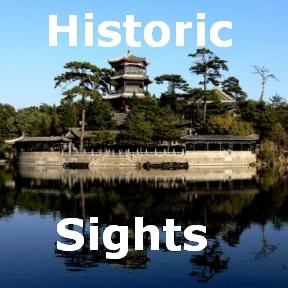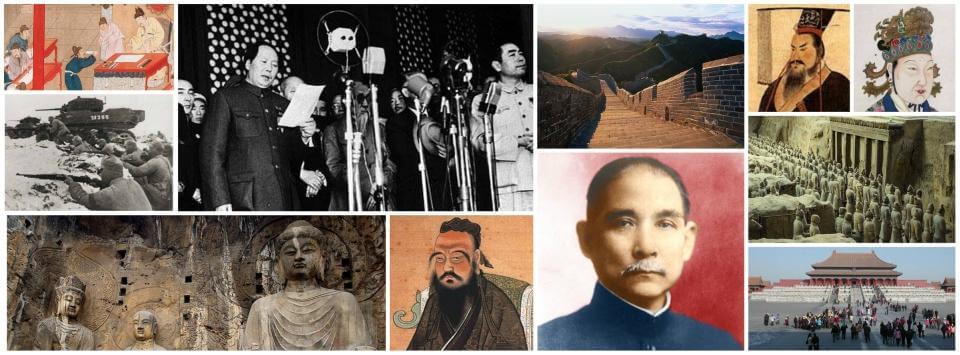
Temple of Heaven
The information contained here are subject to change. Chinese History Digest is not responsible or liable if any changes should occur. If you can read Chinese, you could also check the official website of the Tiantan Park for the latest information.
Opening Hours
Tiantan Park:
April - October: 6am - 10pm
November - March: 6.30am - 10pm
Temple of Heaven:
April - October: 8am - 5.30pm
November - March: 8am - 5pm
Entrance Ticket Prices
Tiantan Park:
April - October: 15 yuan
November - March: 10 yuan
Combo Ticket Park & Temple:
April - October: 34 yuan
November - March: 28 yuan
Combo ticket selling stops 90min before temple closes!
Divine Music Administration: + 10 yuan
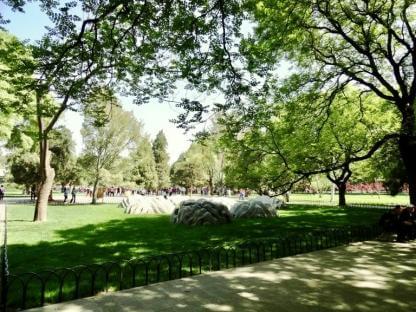 Tiantan Park is a green oasis at the heart of BeijingThe Temple of Heaven is the main attraction of Beijing's Tiantan Park which is located in the southeastern Dongcheng district. It was at this temple that the emperors of the Ming dynasty and Qing dynasty annually performed the Heaven Worship Ceremony to thank the heavens and pray for a good harvest. A few years after the fall of the Qing dynasty when China was officially a republic, sacrifices to heaven were performed once more at the Temple of Heaven but this time by the military and government official Yuan Shikai in his preparations to establish a new imperial dynasty with himself as the Great Emperor of China! Since then, there have been no more 'real' ceremonies at the temple but historical reenactments of such ceremonies are performed from time to time.
Tiantan Park is a green oasis at the heart of BeijingThe Temple of Heaven is the main attraction of Beijing's Tiantan Park which is located in the southeastern Dongcheng district. It was at this temple that the emperors of the Ming dynasty and Qing dynasty annually performed the Heaven Worship Ceremony to thank the heavens and pray for a good harvest. A few years after the fall of the Qing dynasty when China was officially a republic, sacrifices to heaven were performed once more at the Temple of Heaven but this time by the military and government official Yuan Shikai in his preparations to establish a new imperial dynasty with himself as the Great Emperor of China! Since then, there have been no more 'real' ceremonies at the temple but historical reenactments of such ceremonies are performed from time to time.
Tiantan Park and the Temple of Heaven are now primarily tourist attractions and benefiting from the temple's status as a UNESCO World Heritage site, tens of millions of visitors from China and all around the world come here each year. Before reading the detailed explanations that follow in the next paragraphs, readers might want to take a look at this map of the temple grounds in order to get a feeling for the overall layout of Tiantan Park and the temple!
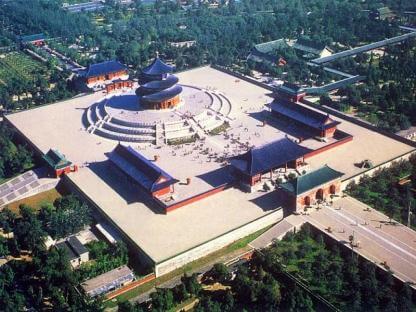 aerial view of the Altar of Prayer for Good Harvests at the Temple of Heaven in BeijingThe temple was originally built as the Altar of Heaven and Earth in AD 1420. Set amidst a landscape of gardens and pine woods, it only consisted of the Hall of Prayer for Good Harvests and the Altar for Grain Prayers back then. In AD 1530, the decision was made to offer separate sacrifices to heaven and earth. For the specific purpose of worshipping heaven, the Imperial Vault of Heaven and the Circular Mound Altar were built to the south of the Hall of Prayer for Good Harvests where the sacrifices to the earth were made. In AD 1534, the temple was then renamed as the Temple of Heaven. Since the completion of reconstruction and enlargement in AD 1749, the temple's appearance has mostly remained unchanged. With its 92 ancient buildings that are dispersed over a total surface area of 2,700,000 square meters (3,529,412 square yards), it is the largest compound of its kind in the world and even dwarfs Beijing's Forbidden City.
aerial view of the Altar of Prayer for Good Harvests at the Temple of Heaven in BeijingThe temple was originally built as the Altar of Heaven and Earth in AD 1420. Set amidst a landscape of gardens and pine woods, it only consisted of the Hall of Prayer for Good Harvests and the Altar for Grain Prayers back then. In AD 1530, the decision was made to offer separate sacrifices to heaven and earth. For the specific purpose of worshipping heaven, the Imperial Vault of Heaven and the Circular Mound Altar were built to the south of the Hall of Prayer for Good Harvests where the sacrifices to the earth were made. In AD 1534, the temple was then renamed as the Temple of Heaven. Since the completion of reconstruction and enlargement in AD 1749, the temple's appearance has mostly remained unchanged. With its 92 ancient buildings that are dispersed over a total surface area of 2,700,000 square meters (3,529,412 square yards), it is the largest compound of its kind in the world and even dwarfs Beijing's Forbidden City.
Since 1988, the Temple of Heaven is accessible to the public as a part of Tiantan Park. Every morning, you will see many people in the park perform their morning exercises. The people of Beijing have embraced Tiantan Park as the ideal place to pursue many popular leisure activities such as jogging, cycling, flying kites, singing and dancing, playing mahjong or chess . . . etc. Especially during the hot summer months, nearby residents will seek the cooling shade that is provided by the more than 60,000 varieties of trees at the park.
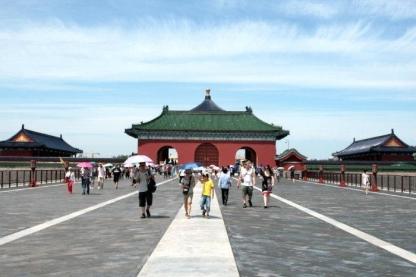 Vermilion Steps Bridge at Beijing's Tiantan ParkThe ancient Chinese belief that the heaven is high and round and the earth is low and square is reflected in the design of the Temple of Heaven. The northern part of Tiantan Park represents the heaven and was purposefully built at a slightly higher elevation. The semicircular outer wall that surrounds the northern part of the park was meant to symbolize the roundness of heaven. Conversely, the squareness of earth is symbolized by the square layout of the outer wall that surrounds the southern part of Tiantan Park. The northern and southern part of the park are connected by the Vermilion Steps Bridge (a.k.a. Danbi Bridge or Imperial Walkway Bridge). Since the southern end of the bridge is lower than the northern end, the emperor and his entourage would symbolically walk from earth to heaven on this 'Sacred Way' when crossing the bridge from the south to the north. Of the three different routes across the bridge, only the emperor was allowed to use the central one. The princes and high-ranking officials respectively used the other two routes to the left and right of the central Imperial Route.
Vermilion Steps Bridge at Beijing's Tiantan ParkThe ancient Chinese belief that the heaven is high and round and the earth is low and square is reflected in the design of the Temple of Heaven. The northern part of Tiantan Park represents the heaven and was purposefully built at a slightly higher elevation. The semicircular outer wall that surrounds the northern part of the park was meant to symbolize the roundness of heaven. Conversely, the squareness of earth is symbolized by the square layout of the outer wall that surrounds the southern part of Tiantan Park. The northern and southern part of the park are connected by the Vermilion Steps Bridge (a.k.a. Danbi Bridge or Imperial Walkway Bridge). Since the southern end of the bridge is lower than the northern end, the emperor and his entourage would symbolically walk from earth to heaven on this 'Sacred Way' when crossing the bridge from the south to the north. Of the three different routes across the bridge, only the emperor was allowed to use the central one. The princes and high-ranking officials respectively used the other two routes to the left and right of the central Imperial Route.
The worship ceremonies that were performed during the Ming and Qing dynasty at the Temple of Heaven were strictly scripted affairs. Ordinary Chinese people were not allowed to witness the event and the smallest procedural error was regarded as a bad omen for the coming year. Before the emperor could perform the various sacrificial rites, he had to fast for several days. During this fasting period, he stayed at the Palace of Abstinence near the Tiantan Park's West Gate.
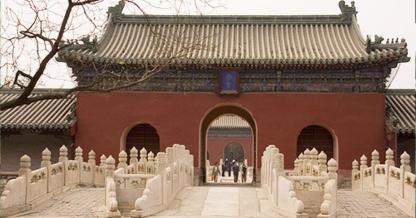 entrance gate to the Palace of AbstinenceMost emperors would go to the Palace of Abstinence three days before the formal Heaven Worship Ceremony. Later emperors however stayed at the Inner Palace of Abstinence inside the Forbidden City until 11pm on the day before the ceremony. Each time that an emperor arrived at or departed from the Palace of Abstinence, a ritual ceremony was held at its main hall, the Beamless Hall. At this large hall that is only supported by its walls and a brick dome, visitors will now also find exhibitions that explain the architecture and all the details of the abstinence system and the sacrificial rituals. History buffs definitely shouldn't miss these exhibitions as they not only include the original sacrificial relics but also pictures of the twenty-two emperors who came to the Temple of Heaven.
entrance gate to the Palace of AbstinenceMost emperors would go to the Palace of Abstinence three days before the formal Heaven Worship Ceremony. Later emperors however stayed at the Inner Palace of Abstinence inside the Forbidden City until 11pm on the day before the ceremony. Each time that an emperor arrived at or departed from the Palace of Abstinence, a ritual ceremony was held at its main hall, the Beamless Hall. At this large hall that is only supported by its walls and a brick dome, visitors will now also find exhibitions that explain the architecture and all the details of the abstinence system and the sacrificial rituals. History buffs definitely shouldn't miss these exhibitions as they not only include the original sacrificial relics but also pictures of the twenty-two emperors who came to the Temple of Heaven.
Surprisingly, fasting didn't mean the same thing for the emperor that it does for most people today. For the emperor, it simply meant to not drink wine and only eat simple vegetarian food. As a part of this cleansing and purification ritual, the emperor also bathed several times during his three solitary days of abstinence. He slept and spent most of his time during this period at the Resting Palace just behind the Beamless Hall. The emperor could read and write at the Study Room there or he could simply relax and drink tea at the main room. The original bookshelves, tables, decorative screens, writing utensils, porcelains etc. can all still be seen in these rooms of the Resting Palace.
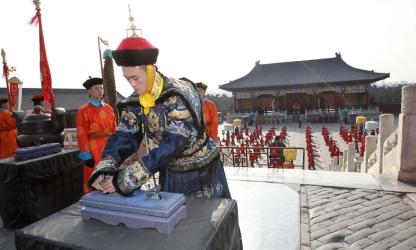 reenactment of the Heaven Worship Ceremony at Beijing's Tiantan ParkThe open-air Circular Mound Altar (a.k.a. the Terrace of Worshipping Heaven) is located to the southeast of the Palace of Abstinence. The most eye-catching feature of this circular stone altar are perhaps the three round white marble terraces with their embellished dragon carvings. The true marvel of the Circular Mound Altar however lies in its geometric and symbolic design involving the number nine. Acoustic features that produce a strong echo are also a result of this special design. Every day, many tourists delight in testing these out from the slightly-raised Heaven Heart Stone (a.k.a. Sun Stone) in the middle of the altar.
reenactment of the Heaven Worship Ceremony at Beijing's Tiantan ParkThe open-air Circular Mound Altar (a.k.a. the Terrace of Worshipping Heaven) is located to the southeast of the Palace of Abstinence. The most eye-catching feature of this circular stone altar are perhaps the three round white marble terraces with their embellished dragon carvings. The true marvel of the Circular Mound Altar however lies in its geometric and symbolic design involving the number nine. Acoustic features that produce a strong echo are also a result of this special design. Every day, many tourists delight in testing these out from the slightly-raised Heaven Heart Stone (a.k.a. Sun Stone) in the middle of the altar.
The Heaven Worship Ceremony was performed once every year on the day of the Winter Solstice. In the early morning of this day, a gigantic bell - the Bell of Supreme Harmony - was struck at the bell tower of the Palace of Abstinence at the time when the emperor departed in direction of the Circular Mound Altar. He then had to change into worshipping clothes at the Dressing Terrace before he could enter the Circular Mound Altar through a specifically designated passage of the Lingxing Gates. After mounting the two flights of steps to the middle layer of the altar, the emperor would kneel down for the first time.
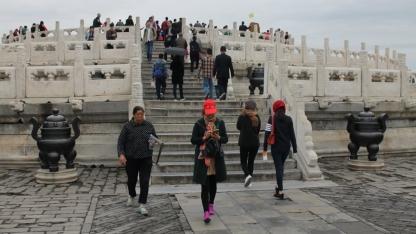 view of the Circular Mound Altar at the Temple of HeavenDuring the meticulously scripted ceremony, the emperor had to kneel, bow and/or kowtow a precisely prescribed number of times in front of the sacrificial tablets that had been arranged all around the altar's middle layer. He would also perform the libation ritual and place sacrificial offerings in front of the tablets. Words of prayer were read, special music and dance performed and at the end of the ceremony, all the offerings were respectfully moved to the Firewood Stove (which stands at the southeastern corner of the altar) and burned under the emperor's watch.
view of the Circular Mound Altar at the Temple of HeavenDuring the meticulously scripted ceremony, the emperor had to kneel, bow and/or kowtow a precisely prescribed number of times in front of the sacrificial tablets that had been arranged all around the altar's middle layer. He would also perform the libation ritual and place sacrificial offerings in front of the tablets. Words of prayer were read, special music and dance performed and at the end of the ceremony, all the offerings were respectfully moved to the Firewood Stove (which stands at the southeastern corner of the altar) and burned under the emperor's watch.
The sacrificial offerings had all been prepared at the Divine Kitchen Courtyard just east of the Circular Mound Altar. Altogether, more than thirty different kinds of offerings were made. Livestock animals (cattle, sheep and pigs) were slaughtered at the Butcher Pavilion on the day before the ceremony. Food items like grains, fruit and wines and even very valuable items such as jade and silk objects were also sacrificed. On the day before the ceremony, the emperor would personally inspect the prepared food and other items at the Divine Kitchen and Divine Storeroom.
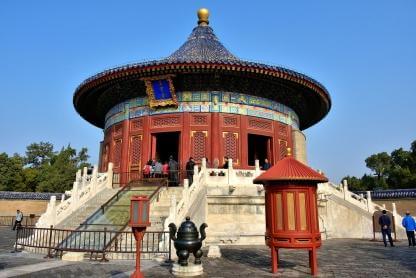 view of the Imperial Vault of HeavenJust north of the Circular Mound Altar stands the Imperial Vault of Heaven and its West and East Annex Halls. The complex is surrounded by the Echo Wall, a circular wall with three colored glazed gates. The most important sacrificial tablets (the Heavenly Great Tablet and the imperial ancestral tablets) were kept throughout the year at the Imperial Vault of Heaven. It is a circular wooden pavilion with a blue-tiled roof topped with a golden sphere. A white marble platform that is enclosed by a stone fence surrounds this magnificent structure. The West and East Annex Halls nearby house the memorial tablets of the moon, star, cloud, rain, thunder and lightning gods.
view of the Imperial Vault of HeavenJust north of the Circular Mound Altar stands the Imperial Vault of Heaven and its West and East Annex Halls. The complex is surrounded by the Echo Wall, a circular wall with three colored glazed gates. The most important sacrificial tablets (the Heavenly Great Tablet and the imperial ancestral tablets) were kept throughout the year at the Imperial Vault of Heaven. It is a circular wooden pavilion with a blue-tiled roof topped with a golden sphere. A white marble platform that is enclosed by a stone fence surrounds this magnificent structure. The West and East Annex Halls nearby house the memorial tablets of the moon, star, cloud, rain, thunder and lightning gods.
Just like the Circular Mound Altar, the architectural design of the Imperial Vault of Heaven complex also possesses special acoustic characteristics. Sound waves that originate from the Dialogue Stone (the 18th stone away from the marble platform) are almost mysteriously carried to the northeast corner of the East Annex Hall and the northwest corner of the West Annex Hall. When standing by the Echo Wall behind one of the annex halls, you could whisper a message that would be clearly understood by someone standing behind the other annex hall. Perhaps most strangely, when speaking from one of the Three Echo Stones and facing the Vault, you will hear either one (when standing on the 1st stone), two (from the middle stone) or three echoes (from the 3rd stone).
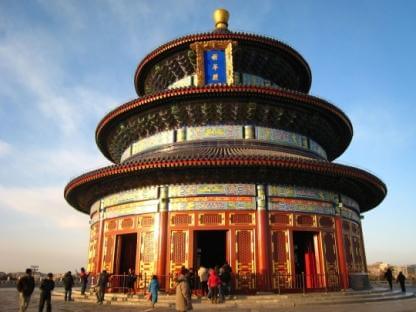 view of the Hall of Prayer for Good Harvests (Qinian Hall) at the Temple of Heaven in BeijingWhen walking further north from the Imperial Vault of Heaven, you will first reach the Vermilion Steps Bridge and then the Altar of Prayer for Good Harvests (a.k.a. the Altar for Grain Prayers). This is the oldest part of the Temple of Heaven where the emperor ceremonially prayed for good weather and a resulting good harvest. Its main buildings are the Hall of Prayer for Good Harvests (Qinian Hall) with its West and East Annex Halls and the Imperial Hall of Heaven. The Hall of Prayer for Good Harvests that sits atop the three-tiered Altar of Prayer for Good Harvests is probably the Temple of Heaven's most iconic building. The blue-glazed tiles on its three layers of eaves are meant to symbolize heaven. The most important feature inside this 38-meter-tall circular building is the Sacred Altar. It stands at the center of this marvelous beamless hall that houses important sacrificial tablets.
view of the Hall of Prayer for Good Harvests (Qinian Hall) at the Temple of Heaven in BeijingWhen walking further north from the Imperial Vault of Heaven, you will first reach the Vermilion Steps Bridge and then the Altar of Prayer for Good Harvests (a.k.a. the Altar for Grain Prayers). This is the oldest part of the Temple of Heaven where the emperor ceremonially prayed for good weather and a resulting good harvest. Its main buildings are the Hall of Prayer for Good Harvests (Qinian Hall) with its West and East Annex Halls and the Imperial Hall of Heaven. The Hall of Prayer for Good Harvests that sits atop the three-tiered Altar of Prayer for Good Harvests is probably the Temple of Heaven's most iconic building. The blue-glazed tiles on its three layers of eaves are meant to symbolize heaven. The most important feature inside this 38-meter-tall circular building is the Sacred Altar. It stands at the center of this marvelous beamless hall that houses important sacrificial tablets.
The Altar of Prayer for Good Harvests with its carved white marble railings is connected by three gates at its northern side to the Imperial Hall of Heaven. It contains shrines that hold tablets and this is also the place where the tablets were consecrated during imperial times. The emperor also performed a ritual here on the day before the ceremony.
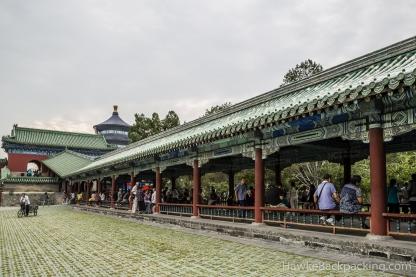 partial view of the Long Corridor to the east of the Hall of Prayer for Good HarvestsJust like the Circular Mound Altar, the Altar of Prayer for Good Harvests is also connected to a Divine Kitchen Courtyard to the east where the sacrificial offerings were prepared in the days before the ceremony. On the eve of the ceremony, this 350-meter-long passage was lit up by lanterns while the offerings were brought to the altar. It is known as the Long Corridor or the Seventy-Two Long Corridors because the seventy-two rooms behind its wall all share the same roof and eave.
partial view of the Long Corridor to the east of the Hall of Prayer for Good HarvestsJust like the Circular Mound Altar, the Altar of Prayer for Good Harvests is also connected to a Divine Kitchen Courtyard to the east where the sacrificial offerings were prepared in the days before the ceremony. On the eve of the ceremony, this 350-meter-long passage was lit up by lanterns while the offerings were brought to the altar. It is known as the Long Corridor or the Seventy-Two Long Corridors because the seventy-two rooms behind its wall all share the same roof and eave.
The West and East Annex Halls of the Hall of Prayer for Good Harvests were originally also used to store tablets but are now used as exhibition halls. The exhibition at the West Annex Halls explains all the details of the Heaven Worship Ceremony and displays various sacrificial utensils. The special worshipping music and dances that were an integral part of this ceremony are the focus of the exhibition in the East Annex Halls.
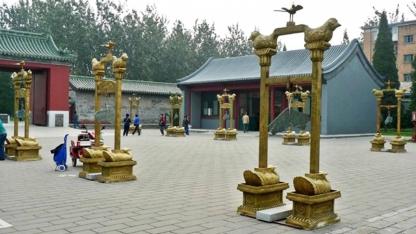 courtyard at the building complex of the Divine Music AdministrationThe musicians and dancers that performed during the Heaven Worship Ceremony practiced throughout the year at the Divine Music Administration. This rectangular building complex with its three courtyards is located in the southwestern part of the Temple of Heaven. The Divine Music Administration was the ritual music academy of the empire. The ritual musicians and dancers trained there and took care of the ceremonial musical instruments. The academy's officials and performers were all adherents of the Taoist faith and their number varied between 300 and 2200 people throughout the centuries.
courtyard at the building complex of the Divine Music AdministrationThe musicians and dancers that performed during the Heaven Worship Ceremony practiced throughout the year at the Divine Music Administration. This rectangular building complex with its three courtyards is located in the southwestern part of the Temple of Heaven. The Divine Music Administration was the ritual music academy of the empire. The ritual musicians and dancers trained there and took care of the ceremonial musical instruments. The academy's officials and performers were all adherents of the Taoist faith and their number varied between 300 and 2200 people throughout the centuries.
When visiting the Divine Music Administration, you can see some ancient musical instruments in the exhibition pavilions that are formed by the 79 verrandas that surround this architectural compound. The two main halls at the center of the compound are the Ningxi Hall (originally named Taihe Hall during the Ming dynasty) and the Xianyou Hall (originally named Xuanwu Hall). Whereas the Ningxi Hall at the first courtyard mainly displays Shao music instruments, the Xianyou Hall just behind it is dedicated to famous ancient Chinese musicians and also displays some ceremonial robes and costumes. Ningxi Hall was already used for rehearsals during imperial times and with a bit of luck, tourists will be able to catch a performance of ancient sacrificial music and dance there.
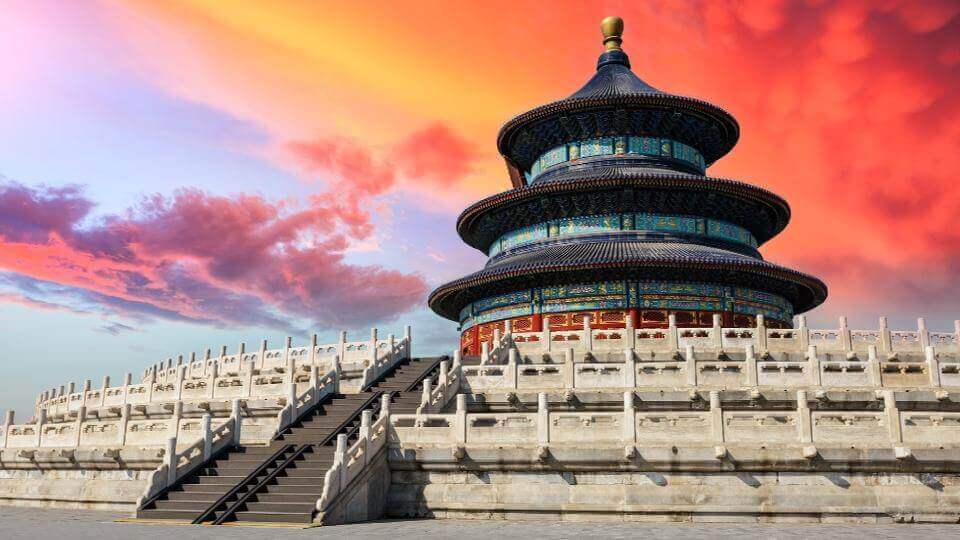 spectacular view of the Altar of Prayer for Good Harvests at the Temple of Heaven
spectacular view of the Altar of Prayer for Good Harvests at the Temple of Heaven
How to get to the Temple of Heaven in Beijing?
| Address: | Temple of Heaven (Tiantan), 1 Tiantan Road, Dongcheng district, Beijing, China |
| Tel.Nr.: | +86 10 6702 8866 |
| Airport: | Beijing Nanyuan Airport (NAY), Beijing Capital International Airport (PEK), Beijing Daxing International Airport (PKX) |
| Train Station: | Beijing Railway Station, Beijing South Railway Station, Beijing West Railway Station, Beijing North Railway Station, Beijing East Railway Station, Qinghe Railway Station |
| Metro: | Tiantan Dongmen Station - Subway Line 5 - Take Exit A and enter through the east gate of Tiantan Park |
| Bus: | Tiantan Nanmen Station - South Gate of Tiantan Park - (bus lines: 36, 53, 122, 525, 958, Te 3, Te 11, Te 12, Yuntong 102); Tiantan Ximen Station - West Gate of Tiantan Park - (bus lines: 2, 17, 20, 36, 53, 71, 72, 93, 120, 622, Brt 1, Te 11); Tiantan Beimen Station - North Gate of Tiantan Park - (bus lines: 6, 34, 35, 36, 72, 106, 110) |
On the following Google map, you can see the location of the Temple of Heaven (the blue pagoda-shaped icon) and the Beijing Hotel NUO (the yellow hotel bed icon) which is our recommended hotel nearby. Further below on this page, you can read a review of this hotel's services and amenities. In case you are planning a trip to China, you could support this website by using the provided affiliate links to check prices and book your hotel accomodation!
You can book hotels in China with both of our affiliate partners Agoda and Trip.com. No matter whether you choose Agoda or Trip.com, you will find many offers on each of these platforms that will allow you to make a risk-free booking with the possibility of free cancellation until a clearly stated date and time, sometimes as late as on the intended date of arrival. However, some deals require prepayment and don't permit cancellation without fees. In that case, the incurred cancellation fees are clearly stated.
When following an Agoda link, the search results will show you prices, availability and special offers for your chosen dates with the recommended hotel in the top search position as well as for other hotels in the same area. Links to Trip.com will take you to the specific hotel webpage where you can then search for availability, prices and special deals with your chosen dates.
The provided information was thoroughly researched from various hotel booking websites. Chinese History Digest is not responsible if any information regarding the provided services and amenities might have changed.
Recommended Hotel near Beijing's Tiantan Park
The Beijing Hotel NUO that is reviewed below is one of the closest 5-star hotels to Beijing's Tiantan Park. In addition to the links to Agoda that are used in the review below, this hotel is also available for booking on Trip.com by following this link.
Beijing Hotel NUO
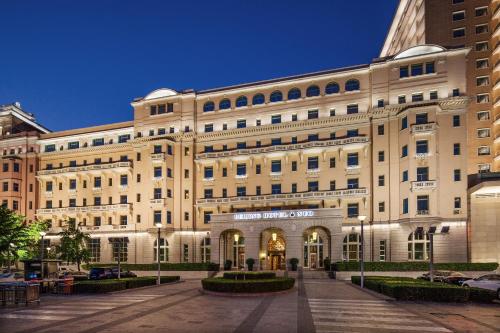 The Beijing Hotel NUO is a 5-star hotel that occupies Block B (built in 1917) of the historic Beijing Hotel. With its classic architecture that attracts attention with its grand colonnade façade, broad marble staircase and interior features such as period-styled rooms and polished 1920s dance floor, this hotel attracts travellers from all over the world that want to experience its mixture of old-world charm and modern comforts (last hotel renovation was in 2006). When it comes to location-related advantages, there is no better place to stay in Beijing than at the Hotel NUO. It is located right at the heart of the city within walking distance of Tiantan Park and also within close walking distance of the famous Wangfujing Street (famous for shopping and eating). What's more, access to the neighborhoods around the hotel is greatly facilitated by the availability of a free shuttle service and the closest subway station (Wangfujing Station) is nearby as well. Of course, the hotel also arranges transportation to and from the airport (for an extra fee of 750 yuan) and guests can request to book that service in advance when making their room reservation online. Travel time between the hotel and the closest airport - Beijing Capital International Airport (PEK) - is typically about 50 minutes.
The Beijing Hotel NUO is a 5-star hotel that occupies Block B (built in 1917) of the historic Beijing Hotel. With its classic architecture that attracts attention with its grand colonnade façade, broad marble staircase and interior features such as period-styled rooms and polished 1920s dance floor, this hotel attracts travellers from all over the world that want to experience its mixture of old-world charm and modern comforts (last hotel renovation was in 2006). When it comes to location-related advantages, there is no better place to stay in Beijing than at the Hotel NUO. It is located right at the heart of the city within walking distance of Tiantan Park and also within close walking distance of the famous Wangfujing Street (famous for shopping and eating). What's more, access to the neighborhoods around the hotel is greatly facilitated by the availability of a free shuttle service and the closest subway station (Wangfujing Station) is nearby as well. Of course, the hotel also arranges transportation to and from the airport (for an extra fee of 750 yuan) and guests can request to book that service in advance when making their room reservation online. Travel time between the hotel and the closest airport - Beijing Capital International Airport (PEK) - is typically about 50 minutes.
All rooms of the Beijing Hotel NUO are air-conditioned and contain a refrigerator, minibar and safe. Free bottled water is provided. Guests have free internet access through Wi-Fi and LAN cable. In addition to standard rooms, the hotel also has family rooms and suites (incl. a bridal suite). Smoking is only allowed in certain designated areas of the hotel (so not inside the rooms)! Laundry service (including dry cleaning) and luggage storage are available. There are three restaurants on-site (plus a bar and a coffee shop) where award-winning chefs prepare gourmet food in a variety of different cuisines. Guests also have manifold choices regarding which type of breakfast they prefer (American, Asian, Continental, Vegan, Buffet). Most room rates include breakfast which can also be purchased separately for 178 yuan if not included. To keep in shape, guests can exercise at the hotel's modern fitness center with its state-of-the-art exercise equipment and enjoy themselves at the hotel's indoor swimming pool.
1.4 miles away
Check availability & prices!